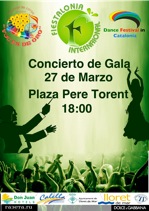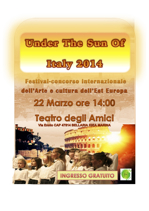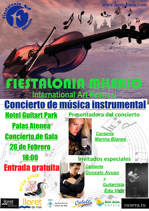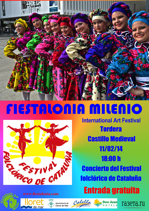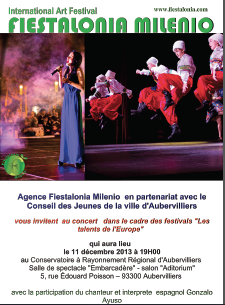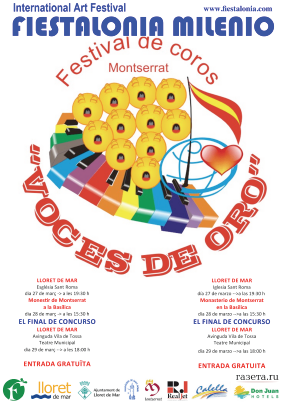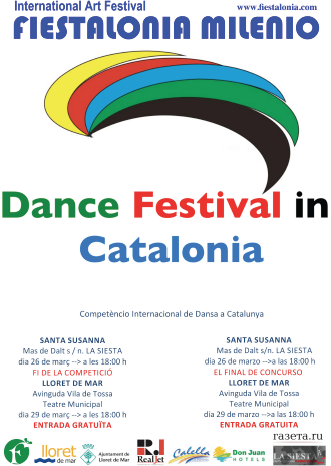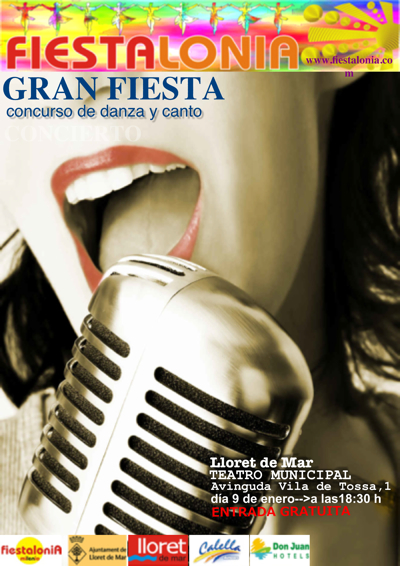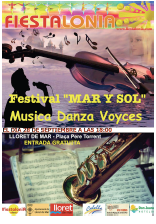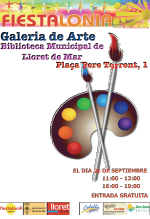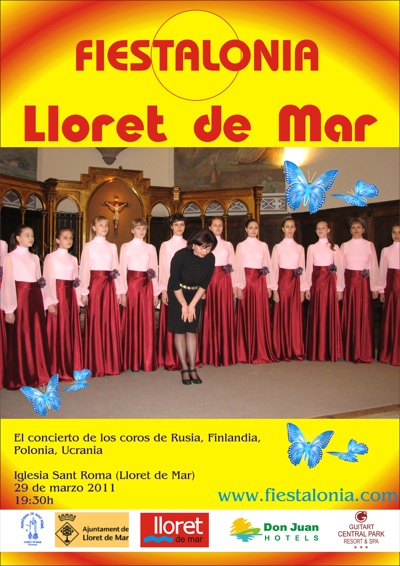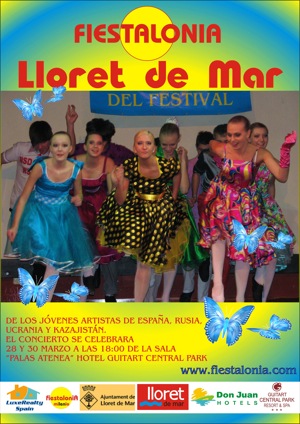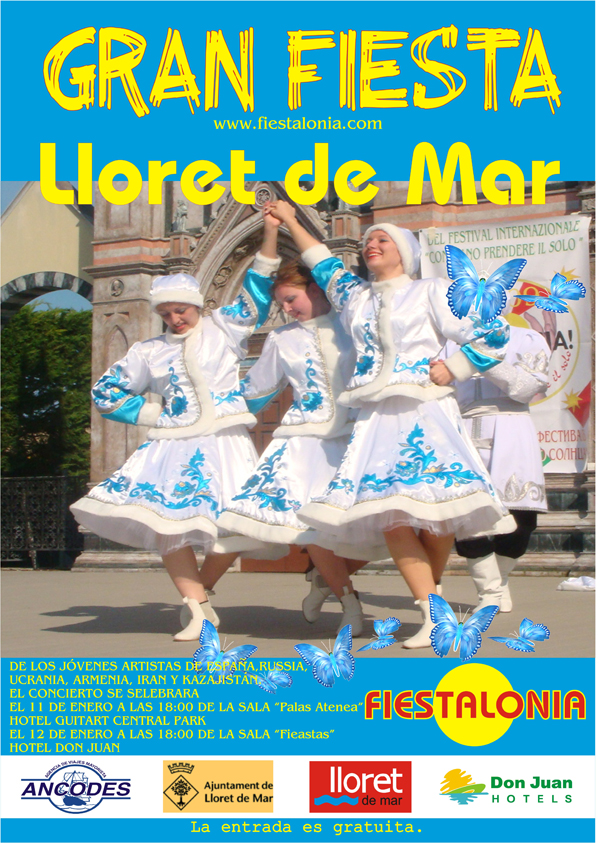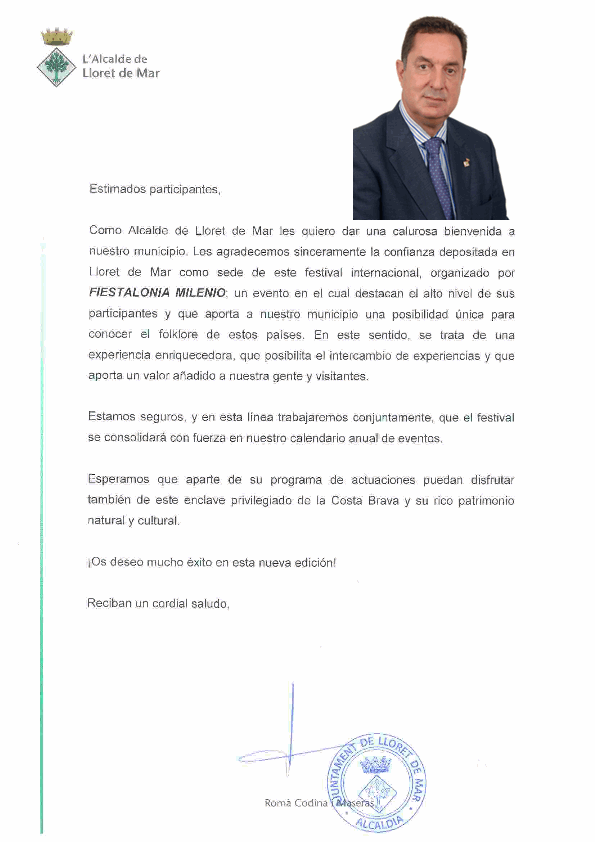TOURS ROUTERS
 Tour routes – it is a very convenient option for the agencies and also creative groups. You can assign the optimum date of your visit to Spain on your own, and we will organize a festival tour. Now you don’t need to adapt to definite dates, you assign them by yourselves!
Tour routes – it is a very convenient option for the agencies and also creative groups. You can assign the optimum date of your visit to Spain on your own, and we will organize a festival tour. Now you don’t need to adapt to definite dates, you assign them by yourselves!
We offer our partners, tourist agencies and also the regions, cities and republics government, - to work out and implement the project whose aim is to familiarize European inhabitants with your region, its history and culture, traditions.
This program is specially designed by us for beginners as well as for those who are already experienced masters of stage.
![]() Reference of mayor Lloret DE Mar to participants of festival:
Reference of mayor Lloret DE Mar to participants of festival:
![]() EVENT DATES:
EVENT DATES:
The whole year round
![]() ABOUT THE PROJECT:
ABOUT THE PROJECT:
-
This project differs cardinally from a chain of various festivals that are held in different countries and these differences are important and considerable. “Tour routes” project enables to plan your tour by your own.
![]() INFORMATION SUPPORT:
INFORMATION SUPPORT:
- Festival is announced in mass media of France, Russia, Kazakhstan, Spain and other countries.;
- Festival results are published in Spanish, French, Portuguese , Russian, Ukrainian, Bulgarian, Kazakh, Georgian, Polish and other media;
- Sponsors of participating groups have an opportunity of special advertising company (e-mail us to get more information: info@fiestalonia.com)
![]() PARTICIPANTS:
PARTICIPANTS:
-
We draw in artists of any ages to participate.
1. choreographic art (dance theatres, groups, ensembles, ballets, soloists);
2. instrumental music – folk, classical (soloists, ensembles, orchestras, individual performers);
3. vocal – folk and academic choirs, ensembles, individual soloists;
4. photo and video art (photo workshops, photo exhibits, studios, authors);
5. decorative-applied art and design (art studios, сstudios, independent masters);
6. theatre of fashion;
7. an art of sounding word (reciters, reciters’ association);
![]() ABOUT THE PROJECT:
ABOUT THE PROJECT:
This project differs cardinally from a chain of various festivals that are held in different countries and these differences are important and considerable. “Tour routes” project enables to plan your tour by your own.
What does it mean?
![]() FOR EXAMPLE:
FOR EXAMPLE:
- your choir performs sacred music, - therefore we can organize your performance in a Catholic Cathedral.
- your orchestra would look well on a town square, OK – we will organize your performance on one of the town’s squares.
- you are a choreographic group, or a folk dance group?- no problem, we will organize your performance in a concert hall
- your choir/group/soloist performs variety songs?- we will give you a chance to realize yourselves on stages.
- you are a secondary school or higher educational establishment?- do you want us to organize you a friendly football/ volleyball/ or basketball match with Spanish persons of the same age?
![]() TO THE DIRECTORS OF GROUPS:
TO THE DIRECTORS OF GROUPS:
To directors of the groups of more than 25 persons, dwelling, transfers and full board at the expenses of the organizers of the competition!
![]() AWARDS: :
AWARDS: :
All groups-participants will be awarded with prizes and diplomas from the holders and the organizers of the Festival. Diplomas of European standard. Sponsors and directors of the groups – letters of thanks on special forms of numbered paper of the Kingdom of Spain. CD disc with photos (to a director of a group).
![]() PRICES:
PRICES:
contract prices
![]() MOREEXCURSIONS:
MOREEXCURSIONS:
We realize how important it is for creative personalities to plunge into immortal works of Gaudi, to see Sagrada Familia and to visit Salvador Dali Theatre and Museum. That is why we’ve worked out a special excursion program for you.
- Barcelona review
- Andorra
- Montserrat
- Tossa de Mar (a fortified town) /for groups of more than 50 persons this excursion is free of charge!/
- Carcasson (France)
- Joust
- Siesta with dinner
![]() HOW TO ARRANGE A TRIP:
HOW TO ARRANGE A TRIP:
To arrange a trip to the Festival contact us
Our e-mail: info@fiestalonia.com
Telephone: +34 972 376550
And we will refer you to an authorized travel agent in your country
![]() TO DOWNLOADAN APPLICATION:
TO DOWNLOADAN APPLICATION:
![]() COMPLETED APPLICATIONS SEND TO: info@fiestalonia.com
COMPLETED APPLICATIONS SEND TO: info@fiestalonia.com
![]() TO DOWNLOAD STATUTE:
TO DOWNLOAD STATUTE:
![]() OUR FESTIVALS HELP TO:
OUR FESTIVALS HELP TO:
Cultivate tolerance. To direct energies to popularization of peace, friendship, brotherhood and solidarity of the peoples of the world by means of art of dance and music, by means of rich revered folk standards of self-expression and intercourse. Associating by means of imagination and art, the representatives of various nations of the world meet and share the most secret: the works of cultural and artistic expression.
Consolidate the image of their own country, republic or city. Just by means of popularization of culture, skills demonstration, our young artists the world will learn your country, nation and even a small settlement…
Self-discipline. Every festival of ours has its own regulations and program, its own features and level of complexity of scoring system. Deviation from the program without agreement with Organizing Committee is not allowed. Clear communication between the Organizing Committee and the teachers, clear adherence to the rules by all the participants of the festival is required.
Mutual help. You should offer your help to producers and teachers because it is a big festival world and during the festival we all are one, big family regardless of the competition on the stage!
Information value. It is advisable to prepare information booklets about your group, to bring souvenirs typical to your country or city because you will be met by officials and some souvenirs will fall into a special museum of “Fiestalonia”. Be ready for the interview with foreign media!
Motivation. The main idea of our festivals is to give an opportunity to boys and girls (schoolchildren and students of Institutes or Universities) to put their dreams into reality, to show other people their abilities, to demonstrate their skills to audience, to enable teachers to share experience! That is the reason why the festival organized by us is big art laboratories for children and youth. Festival is a cultural event that presents work of various groups of the world!
![]() MORE INFORMATION ON EXCURSIONS:
MORE INFORMATION ON EXCURSIONS:
Barcelona - is a capital of Catalonia, a city, which can’t be forgotten if you have visited it at least once. Various styles and epoch mixed in a diverse and unique architecture of this world famous city. A famous, full of majestic antiquity, Barrio Gotico – a Gothic area is situated in a centre, whose highest point is Barcelona Acropolis, here there is a Cathedral which was erected within six centuries. On the northeast from the Gate of Peace, cleaving an old city, a famous boulevard La Rambla, that absorbed all charm, grandeur and immortality of Barcelona’s soul extends. Here at art school studied Pablo Picasso, Catalans Joan Miro, Bunuel and Antonio Gaudi – a genius architect, who never in his life left his Barcelona, who put his dreams and love, all his life in it, who created truly unique city. … Park Guell, Casa Mila, Palacio Episcopal, El Capricho de Gaudi, La Pedrera, Casa Batllo, balustrades, bowers, all sorts of gratings, fencings, stained-glasses!… After all the Sagrada Familia church – one of the most unbelievable and fantastic structures of the 20th, that has become unofficial symbol of today’s Barcelona.
You will never regret the time spent in this city, which is quite often called “the pearl of Catalonia”!
Montserrat as the phenomenon, where nature, culture, self-perception, symbol (Natura, Cultura, Identity, Simbol) are seeking for their unique combination. The whole world of futility is left below. You should only take nutrition, boys with unbroken voice, before their voices change, for a choir accompanied by organ.
Every day at noon, the hymn to God’s Mother- a famous in Catalonia psalm “Virolai” (лат. Virolai de Montserrat) sounds in a church, performed by the boys’ choir who study at musical school at monastery «Escolania de Montserrat». Well-known all over the world musical school was founded in the 13th century and is one of the most ancient educational institutions of Europe. The boys’ choir will take part in all solemn liturgies.
Organ’s music here is like breath of «dissected» space itself (Montserrat – jagged mountain), forge bellows (organ-pipes) are larynxes and lungs of these speechless towered mountains, that gave their voices to a little man at the keys. He, this small fry, is allowed to voice all this power and not to fall to pride. It is not an easy task to place all power of Nature that was sanctified by God, within the limits of prayers, choirs and religious performances.
The first mention of Montserrat monastery is dated 880 year. In the 11th century four small secluded monasteries were there, one of them was devoted to God’s Mother. In 1025 Benedictine Abbey in Romance style was laid here. By 12th century there was a modern architectural ensemble of monastery. During his second travel Christopher Columbus named in honor of Montserrat monastery an island in an archipelago of Lesser Antilles, the British colony now. In 1522 the founder of the Jesuits order Ignacio de Loyola made pilgrimage in Montserrat. In 1592 consecration of a new Cathedral, constructed in style of the Renaissance with the Gothic style elements, was carried out. The Cathedral was notable for its big size, especially if take into account, that it was situated on a rocky precipice. In 1811 the monastery was set on fire and destroyed by Napoleon’s armies. Only the Romance portal of the cathedral and the rests of the Gothic cloister remained from the original buildings of the monastery. Benedictine Abbey was in ruins and desolation. In 1844 monastery restoration, that took about a hundred years, began with Benedictine community and Catalans support. In the 20th century Montserrat became the most tangible symbol of Catalonia and support at a hopeless time in its history. Only inside the cathedral of Montserrat, Masses and weddings in forbidden then Catalan language were held at the time of Franco’s dictatorship.
Montserrat monastery keeps national shrine of Catalonia — a statue of God’s Mother with the baby on her laps of the 12th century, which attracted pilgrims from around the world to the monastery. Because of its dark color 95-centimetric statue made from a black poplar in golden clothes was named «Notre Dame», and Catalans gently name it «La Moreneta» (cat. «Swarthy»). Thanks to care of believers’, who hid it, the statue escaped destruction during monastery’s plunder in 1811. In a Throne room, a queue rise to the sanctuary to warship the saint patroness of Catalonia, to touch her with a hand.
According to the legend a miraculous statue of the Virgin Mary was found by settlers in one of the caves at the time of the Reconquista.
Girls in Catalonia are named Montserrat in honor of the Virgin of Montserrat (Montse for short). For example, a famous soprano Montserrat Caballe has this name.
Tossa de Mar - is one of the most picturesque towns of Costa Brava, that was glorified by poets and that was an inspiration source of many artists that was famous as a holiday resort of rich Europeans at the beginning of the late twenties of the last century.
An extensive town’s beach on one side borders indented rocky shore, where sea rocks form deep mainsails, narrow straits and isolated bays that attract dreamers, romantics and the underwater world explorers. One of the most famous national monuments of Costa Brava a fortified medieval town Villa Vella is situated on the other side of the town’s beach. It was founded in the 12th century and is surrounded with battlemented stone walls with three tall cylindrical towers, this medieval citadel gives particular charm to the whole town. Almost all perimeters of the fortification and the most part of the guard road have remained up to now. One of the most favorite by tourists walking rout passes a stone ladder, and gradually rises to this fortified town and to its twisting footways, that were specially made for visitors. At the highest point of the fortress an admirable view of the sea and the nearest environs opens, and numerous restaurants and cafes, located on the way, invite all interested persons to rest, to listen to colorful Spanish tunes and to taste local delicacies.
Girona+Figueres+Salvador Dali Museum – Girona - is a romantic and mfairy city, where one begins to believe in miracles walking its medieval streets you still in the twilight.
According to the legend, the city’s name came from a three-headed monster Gerio, which came here from the south of Spain. Gerio fell in love with the local beauty called Pyrene, who ran away into the woods surrounding the city. Gerio, who got furious with her recalcitrance and burnt the forest. Pyrene died in a fire. Hercules being the legendary founder of Spain, was also in love with Pyrene and therefore avenged her death and slew Gerio. Thereafter he buried his beloved and piled a huge mountain of stones on her grave – that’s how Pyrenees were formed. Gerio’s three sons in honor of their father founded a triangle citadel on the bank of the river Onyar and called it Girona.
For romanticists Girona is a real treasure. Almost every street, every house has a legend: there s a witch here, who frighten children, a two-tailed mermaid with luxuriant hair, a sly imp who help to get rid of debts, a fool who once heroically amused citizens in a dying from epidemic city and paid with his life for it. Generally accepted habit to throw a coin in a fountain to return, in Girona is substituted with original ritual. There is a proverb in the city “Who doesn’t kiss a back of lioness (leon), won’t be able to become a citizen of Girona”. Now for those who desire to come here once again there is a ladder that is put against the lioness’ back and formerly they had to climb a pillar.
Nowadays some of the buildings and old churches are used as theatres and practice rooms of universities, but an ancient bell is still beats time on the bell tower of the city’s Cathedral that is considered to be the widest in the world, built in Gothic style.
Not far from there, there is a half-ruined tower Gironeya, which reminds heroic scene of city’s defense against Napoleonic soldiers. Girona is called three times immortal for a good reason – three times Napoleon tried to take the city, one third of citizens died and only when Girona lost its defendants, French were able to enter fuming ruins. Then they restored the city and planted plane-trees in a city park among which it is still a great pleasure to walk at any season.
Figueres – can boast of the biggest fortress in Europe and Dali Theatre-Museum. A building under a transparent cupola with eggs on its top was built by Dali’s project on the ruins of the Municipal Theatre, which was destroyed by bombing in the Civil War. Museum’s exposition, if it is possible to call this attraction, was created by Dali: from Cadillac where snails creep on two mossy mannequins in artificial rain in front of the entrance, to the last optical illusion inside. As a matter of fact Dali’s paintings in the museum is not as many (none of them is famous). The grave of the painter in a crypt under the museum is a part of exposition- in spite of the fact that he wanted to be buried next to his wife in her castle in Pubol, he himself even made a gravestone there.
LA SIESTA – a Spanish Night – is a performance of Spanish dances and Flamenco which is successfully held before any public.
Spanish Flamenco play is an evolution of artistic art, which has been improved in La Siesta during the recent years, which has been seen and applauded by thousands of spectators every year.
LA SIESTA is not a simple performance of flamenco, but a work of art, which is distinguished by the highest quality level, an excellent choreography and a large variety of costumes, lighting effects and stage decorations. Our show is the big riches of music and typical dances of Spanish folklore. The show begins with classical Spanish dances performance like Pasodobles and Zarzuelas, next are Flamenco dances with drumbeat percussion carried out with rhythm using boxes, followed by “bulerias” and “solo de pies” or zapateado (akin to tap dance) and ends with livelier and festive dances like Sevililanas and La Rumba Catalana.
![]() TV:
TV:


